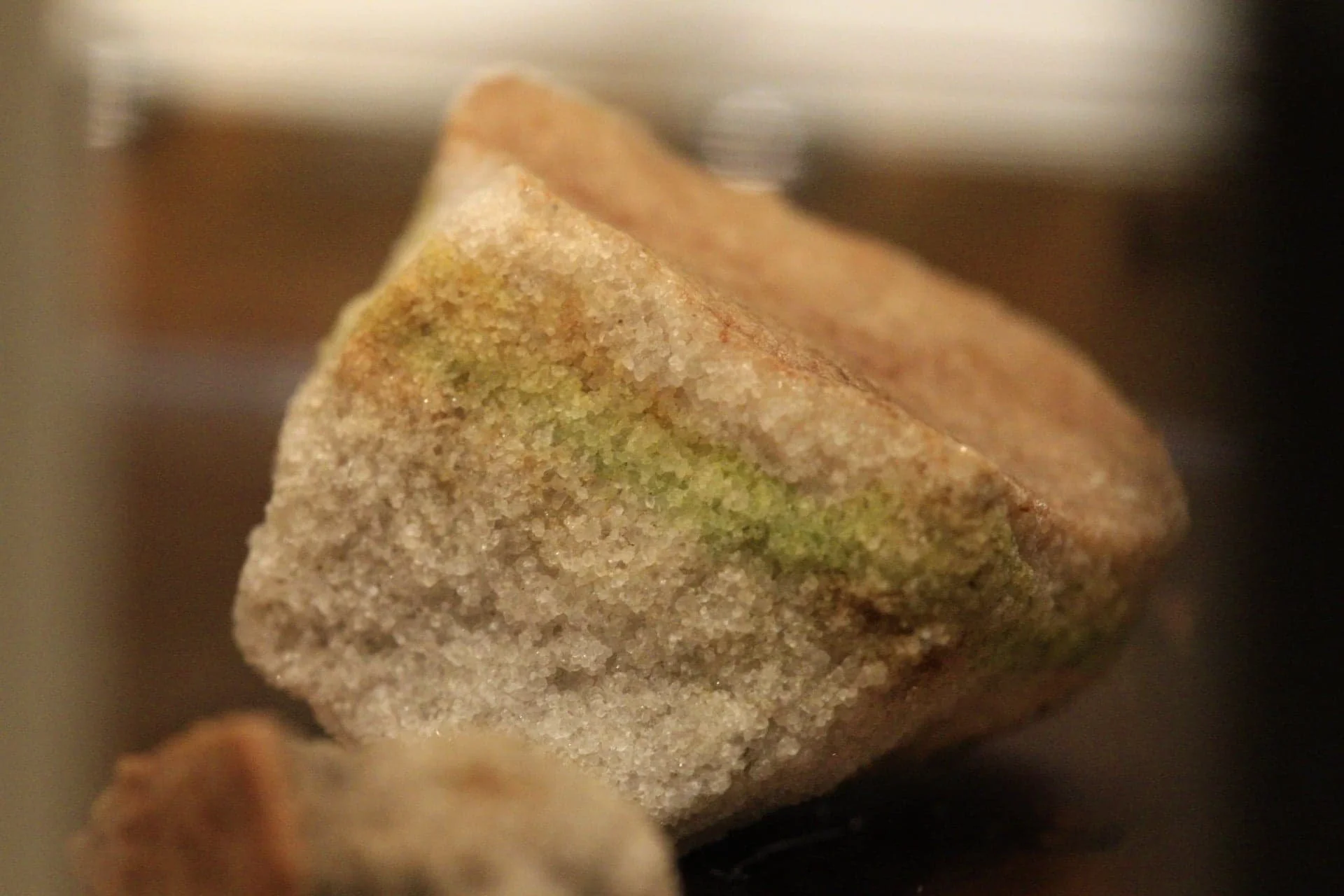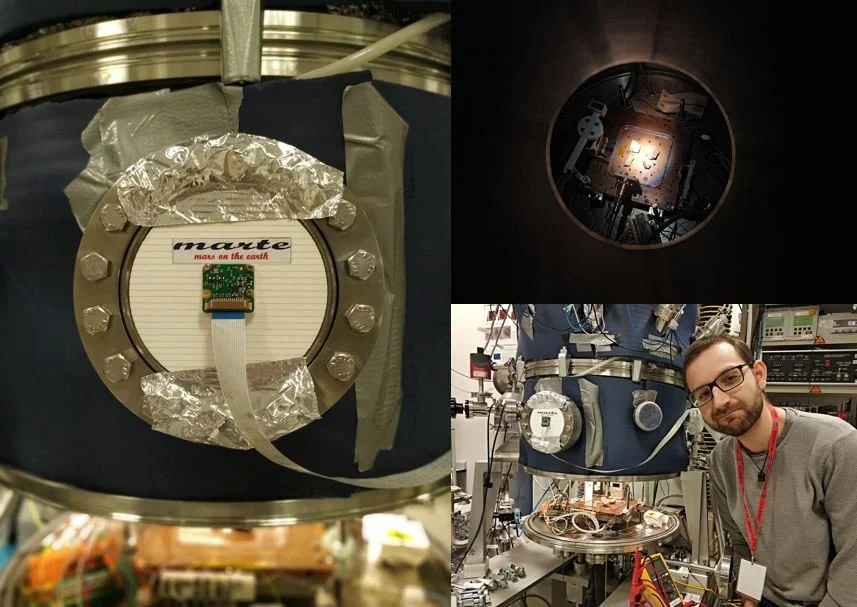Astrobiology Revealed #12: Catherine Maggiori
On zapping hidden life in Mars-analog rocks
by Aubrey Zerkle
This week we chatted with Dr Catherine Maggiori, a postdoctoral researcher in the Department of Biology at Georgetown University, about her paper “Biosignature Detection and MinION Sequencing of Antarctic Cryptoendoliths After Exposure to Mars Simulation Conditions.” Catherine discusses the benefits of definitive molecules like DNA in life detection, and how rocks provide a safe space for microbes in Antarctica and (possibly) on Mars. (This interview has been edited for length and clarity.)
How did you first become interested in applying your skills in biology and advanced sequencing methods to the search for life on Mars?
My interest in space science and astrobiology actually predates my interest in biology and microbiology. I did my undergrad in general biology, and I didn't know that astrobiology was much of a thing until I heard about something Canada used to run - I’m Canadian - called the Canadian Astrobiology Training Program. I just thought “Wow, people do that? That’s amazing!”
I quickly started looking into how to apply biology to space science and astrobiology. The best way I could find was through microbial ecology and extreme microbiology. Of course, there are lots of aspects of astrobiology that relate to biology, like human health and astronaut health, contamination monitoring, things like that. But I found myself really interested in the aspect of life detection, and searching for life and other biomolecules beyond Earth, so I did my PhD in microbiology. From that lens, I was really excited to work on a life-detection-based project. I started looking at analog environments on Earth, and trying to apply methods that are suitable for astrobiological studies and space science studies to extreme sites on Earth that we think are similar to Mars.
In your recent paper in Astrobiology you studied “cryptoendoliths.” Can you tell us what cryptoendoliths are and how they’re relevant to putative Martian life?
Cryptoendoliths are a very cool form of microbial life, or at least I think so! Starting with “endolith”, you can break down that word into “endo” and “lith.” “Lith” refers to rock, so a “lithic” sample would be a rock sample, and “endo” refers to within. So “endoliths,” broadly speaking, are organisms that live within rocks. If you've ever cracked open a rock and you've seen a little green line there, that’s a nice little community of microbes. They generally live close to the surface of the rock but still within the rock.
Then there are several different classifications of endoliths within the rock. “Crypto” refers to endoliths that are indirectly connected to the surface. What that means is instead of having a rock with a crack inside of it that's open to the air, cryptoendoliths are solidly covered. And because the rock is a little porous, they can still access nutrients and light and water from outside, but they get all of the benefits of being protected by the rock mineral matrix.
These microbes are relevant to Mars because we know several billion years ago Mars had a much warmer, wetter environment. It wasn't like a tropical beach, it was more like Earth's current arctic tundra, so “warmer” and “wetter” is relative. But it was still conducive to certain life forms and certainly much more hospitable than it is today. Today Mars is just a dry, freezing, I don’t want to say “hellscape,” but kind of a hellscape! So as Mars went through a global change from its previous warm and wet conditions [to modern dry and frozen ones], anything that could have been alive on Mars would have had to retreat into some kind of hospitable niche that protected it from the harsh conditions outside. Those harsh conditions include freezing temperatures, exposure to severe radiation, and things like that. A good, hospitable niche that offers protection is within rocks, so cryptoendoliths on Earth are a good analog for where any putative Martian life could have gone to survive until today.
Cryptoendolithic rock sample from University Valley, Antarctica, with the characteristic line of green biomass visible.
The cryptoendoliths you worked with came from the McMurdo Dry Valleys in Antarctica - why were the Dry Valleys a good place to find these?
The McMurdo Dry Valleys, as their name suggests, are very very dry. They’re like a very arid tundra or desert area. That’s similar to Mars because it has a very low moisture content, it’s very cold, and with periods of 24-hour light, there is very little cover from solar radiation. So we think it’s a really good analog for the past Martian surface, and certain places on Mars today.
Did you go to Antarctica to collect the samples yourself?
I wasn't the one who collected these samples, unfortunately. They were collected by Jacqueline Goordial, who's a professor at the University of Guelph, and she was a previous grad student and post-doc where I did my PhD, at McGill University. I was lucky enough to go on quite a few field trips during my PhD, but Antarctica is one that I never hit. I did apply to go at the end of 2020, and 2020-2021 were supposed to be my field seasons - as you can imagine, that didn't happen! So I never made it to Antarctica myself, but I did get to touch those special rocks!
Once you got ahold of those special rocks from Antarctica, you put them first in a Mars chamber and then in a separate UV chamber. What were you hoping to test with these two sets of experiments?
A lot of the things that I was working on during this period were related to “definitive” life detection. There are lots of signs and signatures of life - you could consider liquid water a signature of life because all life we know of needs liquid water, life is made up of organic molecules, life needs certain bioessential elements and minerals, and these can all be signs and signatures of life being present, or the ability of life to be present. When I say “definitive” biosignatures, I mean things that are 100% [indicative of life], they are not really ambiguous. You can have organic molecules and liquid water without there being life present, but definitive signs of life would be things you cannot mistake for abiotic signatures. Something like DNA, proteins, or long-chain cellular lipids, because these are all things we’ve never seen before in an environment that didn’t result from life being present. They’re not things that just spontaneously arise.
So definitive life detection is really what I was interested in with this project. Previous work that I had done was detecting life in some analog samples from an inverted river channel site in the desert in Utah. That was a really cool site as well! We collected samples from that site and took them back to the lab and did our life detection experiments. We wanted to see, can we sequence DNA out of this? Can we detect cellular lipids? Do we have any proteins that we could use to diagnose what kind of microbial communities are there? And we could. That was also really interesting, but these samples were Earth samples, they hadn’t experienced the harshness of the Martian environment. With this [Antarctic] project, we really wanted to see if our suite of life detection instrumentation would work on samples that have experienced Mars-like conditions, like low atmospheric temperature and pressure, a really heavy CO2 atmosphere, and high UV radiation.
We did that first [by putting the Antarctic cryptoendoliths] in MARTE, which is the Mars chamber at the Centro de Astrobiología in Spain, and that was a wonderful collaboration. We wanted to see if we could get a little further than the 58-day exposure that we did in MARTE, so UVC was our supplemental exposure, equivalent to almost 300 years. Both of these are very short timescales when you’re talking about the transition of Mars from a warm wet environment to today, these are not geological timescales by any means. But we wanted to push it a little bit more. Because I didn’t have a Mars chamber of my own, we MacGyvered our own exposure setup. And we really wanted to focus on UV because that’s going to be the most destructive effect to those definitive biosignatures. UV will be the thing that destroys DNA, destroys proteins, destroys lipids, faster than freezing temperatures, low pressure, and things like that.
Clockwise from left: exterior view of the MARTE Mars environmental chamber at the Centro de Astrobiologia; overhead view of University Valley cryptoendolith samples within the MARTE interior; co-author Miguel Ángel Fernández-Martínez standing next to MARTE.
So you wanted to test whether any definitive biomarkers were left after you exposed the cryptoendoliths to these harsh Mars-like conditions?
Precisely. Some of our instruments were analogous to instruments that are currently used on Mars missions. A gas chromatograph mass spectrometer has been used on many Mars missions before. The life detector chip, which is an immunoassay microarray, was never used on a mission, but it was a previous candidate payload for ExoMars. And the MinION has never been used on a Mars mission, but it has been used in several extreme environments, and it was tested on the International Space Station. These are our analog space mission techniques, so we wanted to see how they did [with life detection] on samples that were even more similar to Mars than our terrestrial analogs.
It’s so cool to just casually mention “Oh yeah, and they used that on the International Space Station…”!
I feel really lucky getting to play with these [methods], because it feels like play a lot of the time. And especially doing the kind of extreme biology stuff that I get to do. I was like “We got this super cool dirt, and now we’re just gonna zap the hell out of it and see what happens! Yeah!”
That’s your tagline right there, it’s great SciComm!
Exactly! I’m basically like “But this is the coolest dirt! And we’re gonna zap it the strongest!” You know, it’s a very base pleasure in a way. A lot of the time I feel a bit like a caveman just figuring things out, like “Oh a rock! A rock and light, what happen?” It’s great!
When you finished all the zapping, were your results what you expected, or were there any surprises?
For the most part, we were happy with the results and they were what we expected. What we observed was that the microbial community members that were salt tolerant and resistant to being dried out did really well both in MARTE and in the UVC exposure. This is probably because microbes that have methods to deal with high levels of salt and high levels of dryness also tend to be radiation resistant. They have genomic pathways that make them able to survive really high amounts of salts and really dry areas, but they’re also just really great at repairing damage done by UV radiation. The changes in protein and lipid content were pretty much what we expected, and we were certainly happy to see that.
We noticed that a lot of the lipid content tended to suggest destruction of cells. The cells were dying but the remnants of their cellular membranes were still able to be detected. UV radiation just kind of chews up organic molecules and destroys them, so I was expecting to see a more pronounced effect on the DNA content. But the actual DNA content of the samples over both periods of exposure didn’t really have a nice linear decrease like I was expecting. It was kind of like (gestures up and down erratically) a little bit all over the place. And part of that is because these are relatively short timescales, not geological timescales. Cryptoendoliths also tend to be pretty heterogeneous samples, they’re not very uniform. So it can also just be a quirk of sampling that you got a few grams of sample that had a ton of biomass or DNA, and then some samples with much less.
Something else that we were very happy about was that even in the samples where DNA was below the limit of detection, it was still able to be sequenced. Having less than a picogram of DNA, which is like 1 trillionth of a gram of DNA, present and still being able to actually sequence that, even without being able to say necessarily what microbe it came from, is still a very encouraging result for life detection.
That is really encouraging! What are the next steps? Do you have any plans to follow this up, or are you currently following this up with further work?
This project was a part of my PhD thesis at McGill University. I have transitioned to doing a postdoc at Georgetown, so I'm now working in a different lab with a different advisor. I am still working on life detection studies though, and I'm still very much in astrobiology. The project I'm working on now, rather than definitive life detection, is agnostic life detection. What that means is trying to detect life as we don't know it, and that's a very broad statement. The way I'm currently looking at it is to try to find patterns between molecules binding to certain surfaces. I’m seeing if I can get a sequence from certain biomolecules that is indicative of it binding to life, like a cell surface, as opposed to binding to not life, like a rock or a piece of paper. That is agnostic because it doesn't presume anything about what is being bound. You're simply looking at the pattern that results in this molecular complementarity. Is there a pattern that we can group into one section of life and one section of not life? And the answer to that is ongoing!
I am still working a little bit on some radiation experiments and I'm hoping to answer some of the questions that resulted from it. I still have so many questions from this work! Number one, how long would it take before the DNA was completely destroyed and unable to be sequenced? Is that over geological time scales or is this something that is only relevant to samples with microbes that are alive when you dig them out? Because the Martian surface has been irradiated for so many millions of years, if I took a sample from the surface of Mars I wouldn't expect this method to be very applicable. It would have to be on samples that are very recently exhumed. If they’re covered by even just a few millimeters of some kind of regolith, that would be able to offer protection both to any microbes that are still living and to the biosignatures that they may have left behind.
Because so much of my work on this project was focused on the DNA, I’m also really interested in what other effects radiation has on DNA, besides just destroying it. What kind of cross-linkages would be formed, what kind of methylation patterns would be formed? Would the detection of those lead to a signature of life being altered on the very near surface of Mars, and how relevant is that to sequencing on Earth today? These are definitely things that I want to keep exploring and that I’m trying to keep room for.
Do you think this method will be useful for future life detection on Mars?
I'm so glad that I got the opportunity to simulate the Martian environment because I think if we're ever going to consider looking for definitive signs of life on another planet, these are the kinds of analog experiments that need to be done. And certainly there are no plans for any definitive searches for life on Mars coming up that I know of, but I think something like this would also be really relevant to sample return science. It would be a really great way to screen cached samples. It would also be a really great way to monitor forward and backward contamination from samples that you're returning from Earth or from some kind of payload that you are sending to Mars. Screening for lipids, for proteins, and being able to sequence DNA with just such a tiny little device is a really great way to do that.
So I think it's applicable beyond just definitive life detection, and I look forward to seeing more work being done in this space. There are lots of people looking at lipid, protein and DNA biosignatures, and many groups that are working on nanopore sequencing and MinION sequencing as a method for life detection. It’s a very exciting space! Even just in the amount of time that it took from starting this experiment and designing it, the places that parts of molecular biology have gone are light years ahead. It just blows my mind how fast things progress!



